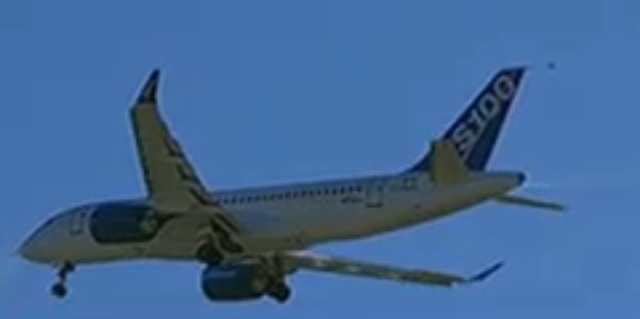After months of delays and build-up, Bombardier’s first CSeries flight test vehicle has finally lifted off, departing runway 06 around 09:55 on a cool morning at Montreal's Mirabel airport.
A crowd of hundreds of mostly Bombardier employees gathered along the runway cheered as the aircraft became airborne – its Pratt & Whitney PW1500G geared turbofan engines nearly inaudible from a few hundred feet away.

“It’s exciting for everybody because now they can see the product and they can see the growth coming in terms of employment for all of us,” says Pierre Beaudoin, Bombardier chief executive.
The maiden flight of the 110-seat CS100 variant, commanded by Bombardier chief test pilot Chuck Ellis, opens a year-long test programme that will be heavily scrutinized to answer crucial questions on which the success of CSeries will depend.
These include whether the CS100’s performance in flight tests will match Bombardier’s promises on reducing fuel consumption by 20% and directing operating cost by 15% and achieving a 3,000nm range.
Even if the aircraft performs as promised, the airframer has yet to discover whether this will coax more airlines to order the CS100 and its 130-seat larger sister, the CS300 – despite heavy competition from the Airbus A320neo, the Boeing 737 Max and re-engined Embraer E-Jet E2.
The most pressing issue for Bombardier is timing the delivery of the first CS100 to launch operator and Swedish regional carrier Malmo Aviation. Bombardier began assembling the first production aircraft in late August.
Bombardier had pegged the CS100’s entry into service to 12 months after the first flight. But nearly two months ago, the airframer said it would re-assess the delivery schedule after the first flight milestone was completed. Several market analysts covering Bombardier already expect the delivery schedule to slide into early 2015.
CSeries was originally scheduled to enter service in late 2013. But Bombardier disclosed a six-month delay last November, attributing the setback to the readiness of certain suppliers.
Transport Canada certificated the Pratt & Whitney PW1500G geared turbofan engine in February.
CSeries remained on schedule to achieve first flight through mid-June and Bombardier executives touted the imminent timing of the maiden sortie during the Paris air show. But installation of software upgrades generated a further delay and, in July, Bombardier loosened its language on the timing of the first flight, simply saying it would occur within “weeks”.
Already in development for five years, the CSeries represents a major gamble for the Canadian manufacturer. It is the first clean-sheet design to enter the traditional narrowbody sector – the seat category above such types as the Sukhoi Superjet 100 and Embraer 190 – since the debut of the A320 in 1988.
CSeries is also the first Bombardier aircraft featuring a new fuselage cross-section and a new wing since the Canadair Challenger 600 appeared in 1978.
Perhaps more ambitiously, the CSeries marks Bombardier’s first attempt to compete against the Airbus and Boeing duopoly.
As a result, the CSeries is loaded with new technology. In addition to the debut of the P&W geared turbofan, it features the first all-composite wing and aluminium-lithium fuselage to be applied in the narrowbody sector. It has a full fly-by-wire flight control system, supplied by Parker Aerospace and integrated into the cockpit by Rockwell Collins.
Bombardier had previously only used fly-by-wire on the rudder of the CRJ1000.
The first CSeries flight occurred within sight of Bombardier’s Mirabel plant, which is being heavily renovated to accommodate CSeries production. Although the CSeries fits within Bombardier’s existing hangars, the company is building a larger and taller factory complex adjacent to the CRJ final assembly plant. At full rate production, the company expects to build up to 120 CSeries jets a year.
Achieving that rate will depend on how fast the company can sell new aircraft. So far, the record has been slow, with only 177 firm orders signed over five years. Bombardier executives remain confident that they can achieve their goal to sign 300 firm orders by the entry into service date.
“We’re in line with our target,” Beaudoin says.
Check out all our exclusive material on the CSeries for free, here in the FG ClubSource: Air Transport Intelligence news


























